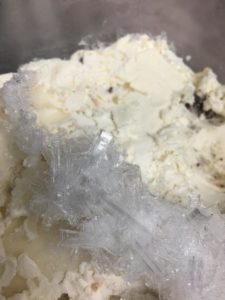4.4.2: Ostwald Ripening
- Page ID
- 19138
Whether in magma or aqueous solution, initial crystallization usually involves many nuclei and small crystals. As crystallization continues, however, larger crystals form at the expense of smaller ones. So, regions around large crystals become depleted in small ones. This occurs because nucleation is a kinetic process. Small nuclei composed of just a few atoms form relatively quickly compared with larger crystals. Larger crystals have greater volume-to-surface-area ratio and lower relative surface energy. This means that larger crystals are more chemically stable because molecules in the interior of crystal are less reactive and have lower energy than those on the outside. Consequently, with time, energetics trumps kinetics and molecules on the outside of small crystals diffuse and add to the outside of larger ones. This process is called Ostwald ripening.


Ostwald ripening explains, for example, why ice crystals form over time in initially smooth ice cream – see Figure 4.31 – which makes old ice cream crunchy. The ripening also explains why large crystals (called phenocrysts) surrounded by a sea of small crystals may form in some volcanic rocks. The rock seen in Figure 4.32 contains phenocrysts of black hornblende in a volcanic rock called andesite. The fine-grained material around the hornblende is mostly plagioclase but includes minor K-feldspar, quartz, and magnetite. Note that the hornblende is euhedral because it was surrounded by liquid (melt) as it crystallized and, consequently, atoms could easily migrate to growing crystal faces.


